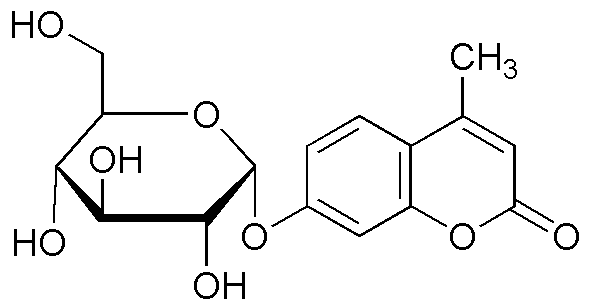4-Methylumbelliferyl-a-D-glucopyranoside is widely utilized in research focused on:
- Enzyme Activity Assays: This compound serves as a substrate for various glycosidases, enabling researchers to measure enzyme activity in biochemical assays. Its fluorescent properties allow for easy detection and quantification.
- Cell Biology: It is used to study cellular uptake mechanisms and glycosylation processes in living cells, providing insights into cellular metabolism and function.
- Food Industry: This chemical can be applied in food testing to detect specific enzymes, helping ensure food safety and quality by monitoring enzymatic activity in food products.
- Biomedical Research: It plays a role in studying carbohydrate metabolism and related diseases, aiding in the development of therapeutic strategies for conditions like diabetes.
- Fluorescent Probes: The compound is utilized in developing fluorescent probes for imaging applications, enhancing the visualization of biological processes in live cells and tissues.
Información general
Propiedades
Seguridad y normativas
Aplicaciones
4-Methylumbelliferyl-a-D-glucopyranoside is widely utilized in research focused on:
- Enzyme Activity Assays: This compound serves as a substrate for various glycosidases, enabling researchers to measure enzyme activity in biochemical assays. Its fluorescent properties allow for easy detection and quantification.
- Cell Biology: It is used to study cellular uptake mechanisms and glycosylation processes in living cells, providing insights into cellular metabolism and function.
- Food Industry: This chemical can be applied in food testing to detect specific enzymes, helping ensure food safety and quality by monitoring enzymatic activity in food products.
- Biomedical Research: It plays a role in studying carbohydrate metabolism and related diseases, aiding in the development of therapeutic strategies for conditions like diabetes.
- Fluorescent Probes: The compound is utilized in developing fluorescent probes for imaging applications, enhancing the visualization of biological processes in live cells and tissues.
Documentos
Hojas de datos de seguridad (HDS)
La SDS proporciona información de seguridad completa sobre la manipulación, el almacenamiento y la eliminación del producto.
Especificación del producto (PS)
La PS proporciona un desglose completo de las propiedades del producto, incluida la composición química, el estado físico, la pureza y los requisitos de almacenamiento. También detalla los rangos de calidad aceptables y las aplicaciones previstas del producto.
Certificados de análisis (COA)
Busque certificados de análisis (COA) ingresando el número de lote del producto. Los números de lote y de partida se pueden encontrar en la etiqueta de un producto después de las palabras "Lote" o "Lote".
Número de catálogo
Número de lote/lote
Certificados de origen (COO)
Este certificado de origen confirma el país en el que se fabricó el producto y también detalla los materiales y componentes utilizados en él y si se deriva de fuentes naturales, sintéticas u otras fuentes específicas. Este certificado puede ser necesario para cumplir con las normativas aduaneras, comerciales y regulatorias.
Número de catálogo
Número de lote/lote
Hojas de datos de seguridad (HDS)
La SDS proporciona información de seguridad completa sobre la manipulación, el almacenamiento y la eliminación del producto.
DownloadEspecificación del producto (PS)
La PS proporciona un desglose completo de las propiedades del producto, incluida la composición química, el estado físico, la pureza y los requisitos de almacenamiento. También detalla los rangos de calidad aceptables y las aplicaciones previstas del producto.
DownloadCertificados de análisis (COA)
Busque certificados de análisis (COA) ingresando el número de lote del producto. Los números de lote y de partida se pueden encontrar en la etiqueta de un producto después de las palabras "Lote" o "Lote".
Número de catálogo
Número de lote/lote
Certificados de origen (COO)
Este certificado de origen confirma el país en el que se fabricó el producto y también detalla los materiales y componentes utilizados en él y si se deriva de fuentes naturales, sintéticas u otras fuentes específicas. Este certificado puede ser necesario para cumplir con las normativas aduaneras, comerciales y regulatorias.


